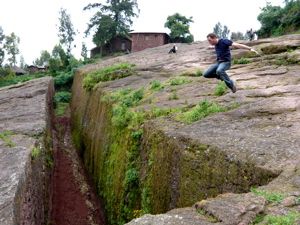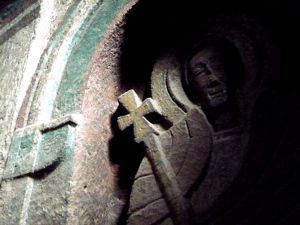The Nigerians on board the flight from Dubai to Addis Ababa were losing their minds. Pushing, shoving and screaming at each other at the check- in counter, one woman ran her overloaded trolley directly into my legs, another woman shoved my back while waiting in line at security. There was nowhere for me to go, Dubai Airport - now officially my worst airport in the world - was slammed from all sides, yet both women were unapologetic. Then, our names weren't on the e-ticket list. Then, someone forgot to tell someone something and no one knew nothing about anything. Then, we finally rushed to board the plane. Then, a fight broke out a few rows down, and women started screaming at each other, and babies started crying. Then, the plane sat on the tarmac for an hour. Then, we took off, and Ethiopian Airlines served up curry chicken, and the pretty flight attendants, battered by verbal abuse, somehow managed to smile at me, and then I realized that I was returning to Africa, and I better get used to it.
Fortunately, and with no disrespect to Nigerians in general, 98% of the plane continued onwards to Lagos, depositing us in Addis Ababa just two days after the country celebrated its millennium. Ethiopia does more than follow its own Christian calendar (the Julian, as opposed to our Gregorian), they also tell the time differently, with 12 hours of day, and 12 hours of night, so we arrived at eight, but it was really two. Thus, I arrived in the country a full seven years younger and ahead of my time. Our luggage, on the other hand, took an hour to make its way to the conveyer time, or, if you prefer, just a few minutes in Africa Time. Oh Africa! Birthplace of Humanity, Land of Beauty, the Place that Progress Forgot (or at least, Overlooked). We had missed the Millennium Party due to scheduling, but Addis was still aglow with festive colored lights, its roads wide and dusty, snaking through tin shacks and creaky wooden scaffolding, holding up leaky cement construction. The Greeks called this the Land of Burnt Faces, a politically incorrect term that has nevertheless given the country its name. It is one of only two countries on the entire continent that has proudly never been colonized, but it is also a highway lined on either side with war and famine - the tragic car wrecks of history. Speaking of which, there was no time to explore the capital just yet; an early morning flight was ready to take us north, to incredible rock churches that have survived from the ancient kingdom of Lalibela.
 As if. Cars break down, boats break down, I've been on a train that broke down, and a gondola once got stuck too. So it came as no surprise when the twin-prop Fokker 50 took off after a quick stop in Bahir Dar, circled over Lake Tana - the source of the world's longest river, the Blue Nile - and bumpily landed again. The plane had broken down. So the passengers, made up of adventurous international tourists, Rastafarians, and a few locals walked into the airport to be served up coffee, bread soaked in berbere sauce, and rain drops of misinformation from the airline. It was the weather, no, the weather instrument, no, we're not sure, more coffee? Five hours later, a replacement plane arrived, but unfortunately, it broke down too. So the passengers from the replacement plane were transferred to our plane, which apparently now worked, and we would have to wait for a replacement replacement plane. I didn't mind so much, because one of these fokking Fokkers was bound to go down, and my bet was the one that "suddenly" fixed itself. The airport toilets didn't flush and there was no water, but I sat through my first Ethiopian coffee ceremony (which can take an hour) and unplugged the cafe fridge to do some work on my laptop. Three hours later, an unmarked Fokker arrived to the cheers of the by-now somewhat irate passengers. Then the airport staff, with whom we'd be mindlessly bantering with all day, turned all professional and emptied our bags as a security precaution, barred us from going outside, and wanted the tape from Sean's camera. It was all rather odd, but eight hours later the plane took off, and, where was I, yes, the ancient kingdom of Lalibela. As if. Cars break down, boats break down, I've been on a train that broke down, and a gondola once got stuck too. So it came as no surprise when the twin-prop Fokker 50 took off after a quick stop in Bahir Dar, circled over Lake Tana - the source of the world's longest river, the Blue Nile - and bumpily landed again. The plane had broken down. So the passengers, made up of adventurous international tourists, Rastafarians, and a few locals walked into the airport to be served up coffee, bread soaked in berbere sauce, and rain drops of misinformation from the airline. It was the weather, no, the weather instrument, no, we're not sure, more coffee? Five hours later, a replacement plane arrived, but unfortunately, it broke down too. So the passengers from the replacement plane were transferred to our plane, which apparently now worked, and we would have to wait for a replacement replacement plane. I didn't mind so much, because one of these fokking Fokkers was bound to go down, and my bet was the one that "suddenly" fixed itself. The airport toilets didn't flush and there was no water, but I sat through my first Ethiopian coffee ceremony (which can take an hour) and unplugged the cafe fridge to do some work on my laptop. Three hours later, an unmarked Fokker arrived to the cheers of the by-now somewhat irate passengers. Then the airport staff, with whom we'd be mindlessly bantering with all day, turned all professional and emptied our bags as a security precaution, barred us from going outside, and wanted the tape from Sean's camera. It was all rather odd, but eight hours later the plane took off, and, where was I, yes, the ancient kingdom of Lalibela.
t must have come as a surprise to European missionaries arriving on the Dark Continent, eager and ready to convert heathen savages, only to discover that Ethiopia was the second country to adopt Christianity as a state religion, as early as the 4th century. An ancient kingdom, known as the Aksumites, was one of the largest, most civilized, and prosperous nations of its era, benefitting from its position as a vital trading post between Africa, Asia and the Middle East. While Europeans were living in caves and hogshit, northern Ethiopia was awash in colourful art, incredible architecture, music and commerce. The Aksumites faded with the rise of trading posts along the Red Sea, but a new kingdom arose in the 11th century, led by a King Lalibela, who decided to build a New Jerusalem in Africa, just in case the rising Islamic empire swept the real Jerusalem into the paper shredder of history. And thus began the construction of the churches of Lalibela, hand-carved into red volcanic rock, a mind boggling accomplishment. Jordan's Petra is similarly carved into a rock face, but the 11 churches of Lalibela stand on their own, like the finished masterpiece of a sculptor. Built alongside its own River Jordan, Lalibela is rich with symbols, icons and religious images. And uniquely, they have survived and are still in use to this day.
 Lalibela attracts tourists - Italians, Spanish, Japanese - the resulting influx barely enough to support the town that surrounds the churches. The Ethiopian word for foreigner is "ferengi", and be it an accident of decades of foreign aid, or just irresponsible tourists who should know better, ferengis in Lalibela (and elsewhere, as we'll soon discover) are good for only one thing, and that is, handouts. Seconds after departing our van, my ass still vibrating from the stone road, I'm surrounded by children asking for birr (Ethiopian currency). I'm prodded and poked and stare into dozens of upturned hands. An old toothless woman walks up from behind and gives me a sloppy wet kiss on my arm. So accustomed to my personal space, I try not to freak out. A guard walks up, raises a stick, and the children scatter. We enter the main gate and buy $20 tickets and pricey $30 video camera permits, and are assigned a compulsory guide as well as someone to watch our shoes when we enter the churches . UNESCO , in an attempt to preserve the main church of Bet Medhane Alem, have installed ugly scaffolding around it, designed, no doubt, to ruin all photographs. Still, the fact that this huge building was carved top-down from solid rock is staggering. We take off our shoes, and enter inside. It is dark and cold and still has much of the original carpeting on the ground (we were warned to wear long pants because of the fleas). Light streams in from small windows, the ceiling blackened from centuries of candle smoke. Voices echo, dark corners hide piles of carpet and wood, angles and demons. Forget the polished gloss of Europe's superstar churches. Here, you can feel every one of Lalibela's 800 plus years, breathe in the past (along with the thick dust). A robed priest is happy to pose for pictures for a few birr, protecting the sacred inner chamber, housing a replica of Ethiopia's holiest object, the legendary Ark of the Covenant. Lalibela attracts tourists - Italians, Spanish, Japanese - the resulting influx barely enough to support the town that surrounds the churches. The Ethiopian word for foreigner is "ferengi", and be it an accident of decades of foreign aid, or just irresponsible tourists who should know better, ferengis in Lalibela (and elsewhere, as we'll soon discover) are good for only one thing, and that is, handouts. Seconds after departing our van, my ass still vibrating from the stone road, I'm surrounded by children asking for birr (Ethiopian currency). I'm prodded and poked and stare into dozens of upturned hands. An old toothless woman walks up from behind and gives me a sloppy wet kiss on my arm. So accustomed to my personal space, I try not to freak out. A guard walks up, raises a stick, and the children scatter. We enter the main gate and buy $20 tickets and pricey $30 video camera permits, and are assigned a compulsory guide as well as someone to watch our shoes when we enter the churches . UNESCO , in an attempt to preserve the main church of Bet Medhane Alem, have installed ugly scaffolding around it, designed, no doubt, to ruin all photographs. Still, the fact that this huge building was carved top-down from solid rock is staggering. We take off our shoes, and enter inside. It is dark and cold and still has much of the original carpeting on the ground (we were warned to wear long pants because of the fleas). Light streams in from small windows, the ceiling blackened from centuries of candle smoke. Voices echo, dark corners hide piles of carpet and wood, angles and demons. Forget the polished gloss of Europe's superstar churches. Here, you can feel every one of Lalibela's 800 plus years, breathe in the past (along with the thick dust). A robed priest is happy to pose for pictures for a few birr, protecting the sacred inner chamber, housing a replica of Ethiopia's holiest object, the legendary Ark of the Covenant.
Recall Raiders of the Lost Ark: Indiana Jones gets wind of a Nazi plot to find the ancient Ark of the Covenant, built by the Israelites to house the tablets of the Ten Commandments, given to Moses by God. The Nazis want it because, according to biblical history, the Israelites were invincible in battle so long as they had the Ark at their side. It apparently unleashed a powerful light that decimated their enemies. Moses apparently had to wear a veil after he gazed at the Ark, as it burnt his face. The Nazi's believed the Ark to be nothing less than a powerful weapon, and they were right, the suckers , as Indiana cleverly looked away and the Ark unleashed its supernatural power, killing all the bad guys, and melting the creepy Nazi guy with the glasses (which gave me nightmares for months). Classic movie, mixing myth and history - and the best part is, the truth is possibly not too far off.
 I first became inspired to visit Ethiopia after reading The Sign and the Seal by Graham Hancock. An English journalist formerly with the Economist, Hancock spent over a decade researching the real story, becoming a literary Indiana Jones, with the resulting book a fantastic mix of history, myth and adventure. For what became of the Ark remains one of history's greatest unsolved mysteries. Its disappearance has been linked to the Knights of Templar, King Solomon's relationship with Queen Sheba (which resulted in the birth of the first great Ethiopian ruler, Menellek), and all manner of conspiracy theories. Since Ethiopia's holiest object is the Ark of the Covenant, and its language shares many Hebraic commonalities, and the country even held tribes of "lost" Jews, Hancock spent much of his time figuring out how this all came to be. His logic and conclusions are controversial but sound, and having briefly met the guy many years ago, I can testify that he's definitely no conspiracy theory nut. Accordingly, the Ark (or an ancient replica) is believed to exist in Aksum up north from Lalibela, where it is zealously guarded by priests, and not even the President of Ethiopia is permitted to see it. An Israeli traveller tells me her investigations lead her to believe the Ark was destroyed, or maybe it's sitting in a big warehouse somewhere in Washington D.C, we'll probably never know. But here in Lalibela, where the Ark passed through, you can still feel the magic of the mystery. I first became inspired to visit Ethiopia after reading The Sign and the Seal by Graham Hancock. An English journalist formerly with the Economist, Hancock spent over a decade researching the real story, becoming a literary Indiana Jones, with the resulting book a fantastic mix of history, myth and adventure. For what became of the Ark remains one of history's greatest unsolved mysteries. Its disappearance has been linked to the Knights of Templar, King Solomon's relationship with Queen Sheba (which resulted in the birth of the first great Ethiopian ruler, Menellek), and all manner of conspiracy theories. Since Ethiopia's holiest object is the Ark of the Covenant, and its language shares many Hebraic commonalities, and the country even held tribes of "lost" Jews, Hancock spent much of his time figuring out how this all came to be. His logic and conclusions are controversial but sound, and having briefly met the guy many years ago, I can testify that he's definitely no conspiracy theory nut. Accordingly, the Ark (or an ancient replica) is believed to exist in Aksum up north from Lalibela, where it is zealously guarded by priests, and not even the President of Ethiopia is permitted to see it. An Israeli traveller tells me her investigations lead her to believe the Ark was destroyed, or maybe it's sitting in a big warehouse somewhere in Washington D.C, we'll probably never know. But here in Lalibela, where the Ark passed through, you can still feel the magic of the mystery.
We explore the rock churches, walking inside carved rock tunnels, peering inside doorways to find weathered priests reading leathered bibles. If only I could blink and take photos with my eyes - the images are unforgettable. Bet Golgotha, another dark and dusty rock church, houses the tomb of Lalibela and is forbidden to women. The priests don their robes, display the ancient crosses, 11th century religious paintings still hold their bright colours. By lunch time, we are escorted out the three main churches, and head over to the House of Saint George, by far the most visually impressive of the lot. Shaped like a Greek cross, it is blessedly scaffold-free, carved into a gash of surrounding rock. The bones of 14th century pilgrims protrude out of "hermit holes", where holy men once meditated. Channels have been carved for rainwater to flow, and a priest points out King Lalibela's olive-tree wooden treasure chest from eight centuries ago. My white socks are red from the earth. The sun breaks between the clouds, the church begins to glow. Read Robin's complete report at his website: moderngonzo.com
< back to the episode
< back to the list of articles |

